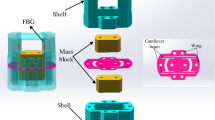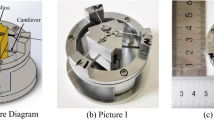Abstract
In this study, an intensive comparative analysis of two impact-sensitive cantilever sensors for improved estimation of time difference of arrivals on plates is presented. Precise locating of the impact point requires exact bending wave propagation velocity due to the impact and time differences between each sensor. However since the bending wave velocity is dispersive on a plate, it is very difficult to decide the velocity when a vibration sensor such as an accelerometer is used. The new sensor philosophy is to provide a more exact bending wave velocity by designing the sensor as a cantilever type with a piezo transducer. Thus in this paper, two different cantilever sensors are considered: a rectangular type with a piezoelectric magnesium niobate — lead titanate single crystal patch and a circular type with a piezoelectric zirconate titanate disc. Their responses against impacts are compared with the response of a commercial accelerometer. The two sensors were manufactured and tested on a glass plate and an MDF plate separately. The impact test results showed that the two sensors give narrow band responses against impacts on the both plates and can provide a constant bending wave propagation velocity.
Similar content being viewed by others
References
A. Dix, J. E. Finlay, G. D. Abowd and R. Beale, Humancomputer interaction (3rd Ed.), Prentice Hall (2003).
A. K. Bhowmik, Z. Li and P. J. Bos, Mobile displays: Technology and applications, Wiley (2008).
J. S. Wilson, Sensor technology handbook, Newnes (2005).
Y.-S. Lee, Effects of windowing filters in leak locating for buried water-filled cast iron pipes, Journal of Mechanical Science and Technology, 23 (2009) 401–408.
C. H. Knapp and G. C. Carter, The generalized correlation method for the estimation of time-delay, IEEE Trans. Acoust., Speech, Signal Processing, 24 (1976) 320–327.
K. F. Graff, Wave motions in elastic silids, Dover (1975).
J. O. Smith and J. S. Abel, Closed-form least-squares source location estimation from range-difference measurements, IEEE Trans. Acoust. Speech Signal Processing, 12 (1987) 1661–1669.
J. S. Bendat and A. G. Piersol, Random data: Analysis and measurement procedures (4th Ed.), Wiley (2010).
S. K. Lee, Identification of impact force in thick plates based on the elastodynamics and time-frequency method (I), Journal of Mechanical Science and Technology, 22 (2008) 1349–1358.
Y. -S. Lee, P. Gardonio and S. J. Elliott, Coupling analysis of a matched piezoelectric sensor and actuator pair for vibration control of a smart beam, J. of Acous. Soc. of Am., 111 (2002) 2715–2726.
R. D. Blevins, Formulas for natural frequency and mode shape, Robert E. Krieger Publishing Company (1979).
L. E. Kinsler, A. R. Frey, A. B. Coppens and J. V. Sanders, Fundamentals of acoustics (4th Ed.), Wiley (1999).
Author information
Authors and Affiliations
Corresponding author
Additional information
Recommended by Associate Editor Heung Soo Kim
Young-Sup Lee received his BS degree in Naval Architecture from Pusan National University, Korea, in 1987. He then received his MSc and PhD degrees from University of Southampton, United Kingdom, in 1997 and 2000, respectively. He is currently an associate professor at Department of Embedded Systems Engineering in University of Incheon, Korea. His research interests include active control of sound and vibration, signal processing, and smart sensors and actuators.
Sang-Kwon Lee was born in Pusan, Korea, in 1959. He studied mechanical engineering at the Pusan National University, Pusan, Korea for his bachelor’s degree. In 1998 he received his Ph.D. in signal processing at the ISVR (Institute of Sound and Vibration Research) of the University of Southampton in U.K. He has 11 years experience in automotive noise control by working in Hyundai Motor Co. and the Renault-Samsung Motor Company in Korea. In 1999, he moved to Inha University, Inchon, Korea, where he became a professor and continued research on the acoustics and vibration signal processing in the Department of Mechanical Engineering.
Kihong Shin received his BS degree in Precision Mechanical Engineering from Hanyang University, Korea, in 1989, and his MSc degree in Design of Rotating Machine from Cranfield University, UK, in 1994. He then received his PhD from University of Southampton, UK, in 1996. Dr. Shin is currently a professor at Department of Mechanical & Automotive Engineering in Andong National University, Korea. His current research interests include all aspects of signal processing techniques related to sound and vibration applications, vibration isolation (linear and non-linear methods), and shock & vibration testing.
Rights and permissions
About this article
Cite this article
Lee, YS., Lee, SK. & Shin, K. Comparative analysis of two impact-sensitive sensors for improved estimation of time difference of arrivals. J Mech Sci Technol 26, 3193–3200 (2012). https://doi.org/10.1007/s12206-012-0828-2
Received:
Revised:
Accepted:
Published:
Issue Date:
DOI: https://doi.org/10.1007/s12206-012-0828-2




